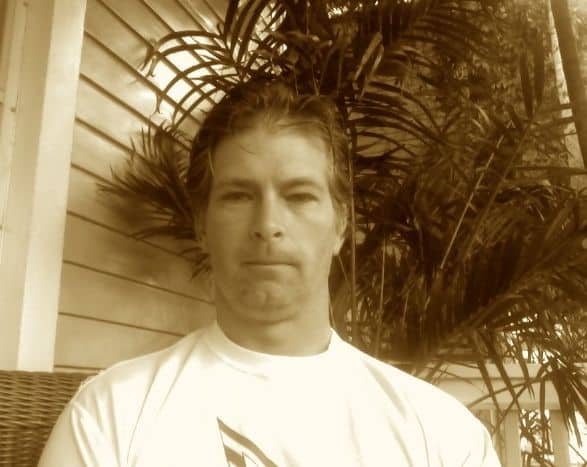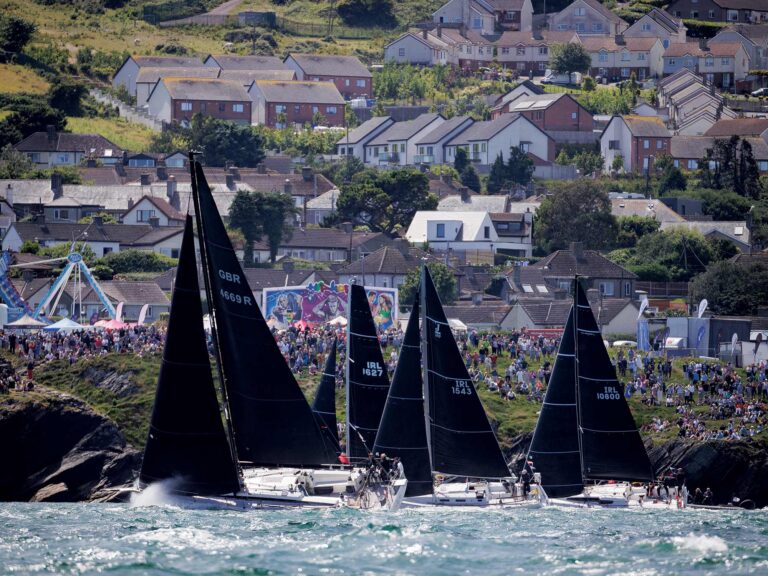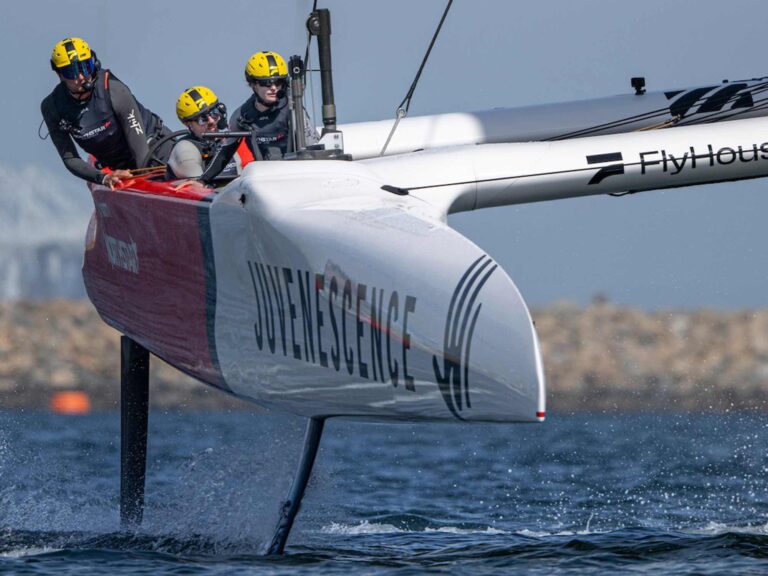
Dave Reed: Quantum Key West
Friday, January 25
The Final Four
A week ago, as you may recall (if not, see below), I joined The Starting Three in Key West, full of uncertainties. A new boat, a new team, zero practice days, and a lot to figure out: who does what, who sits where, what’s the right headstay length, and on and on.
Our first two starts were terrible, and in light winds, comebacks don’t happen easily. That’s where the double-digit points came in. The next day, we went 3,3,1. The Tim Healy (as labeled on his recyclable metal water bottle on the boat), shook off whatever it was that was occupying his mind, and started like the expert he is. After winning the last race of the day, he joked with a wry smile, “Well, at least I know I don’t suck.”
The confidence boost set us down a positive path for the rest of the week, as the scoreline shows. We each refined our own job: Tim starting, and mastering the art of what John Mollicone calls “the lazy plane” . . . a mode not quite high reaching or soaking too low . . . that magical place in between. In windy conditions, John applied his J/24 jib cross sheeting techniques, kept copious notes on every half turn of the rigging, and calmly guided us down the windy reaches, in and out of crowded roundings. All-Star tactician Geoff Becker smoothed out the spinnaker trim, and always kept us in check with the shifts and the fleet.
For my part, my goal after the first shrimp early in the week was to never let it happen again. This is easier said than done on the J/70, and laying in bed at night, I’d go through the mechanics, and each day Geoff and I worked in better sync, sneaking the tack no further than the bow-eye, and me keeping tension on the foot. That seems to be the trick that worked for now, but I’m not convinced it’s the perfect way to do it.
But the collective improvements continued to add up, and at the start of the final day we were in the lead, ahead by a mere point to Brian Keene’s Savasana. These guys had been fast all week, and were not going to let us get away with easy.
In the first start, another good one, Healy held a thin lane in the chop with his technique of playing the main in the puffs, and “pressing” on the jib in the puffs. As he’d done all week, and open lane was an exit, and on an open racecourse he’s blazing fast. We led around the track, and finished just ahead of Savasana to set up a nerve wracking finale.
As we went into the final race Mollicone had all the point configurations penciled out in his notepad. The only game plan was to beat Savasana. If we could do that, the regatta was ours.
We got a way clean again with a wide-open lane, from the middle of the line, and it was all Tim Healy needed to get Helly Hansen flying. We were first to the weather mark, led down the right side, jibed and separated across the course from Keene and crew. A few jibes later, we crossed, split gates, and went to far opposite sides of the final beat. It was a nervous 20 minutes as shifts came and went, the lead changing with each, until we met several hundred feet to leeward of the upwind finish line. We tacked to leeward (onto port) of Savasana, and inch-by-inch Healy climbed to weather and forward until we were half a length forward. We simultaneously tacked, set up to weather of them by mere inches, and scooted out ahead to finish by a bow’s length.
And with that, Healy finally cracked the biggest smile of the week, as if a burden had been lifted. He could finally relax. The Final Four had brought it home.
Now, we can all relax, have a few rums, and hit Duval street for the first time. Our work is done. It’s time to play.
Wednesday, January 23
Contact happens, and most of the time you don’t see it coming. It’s inevitable, though, especially when there are 39 white, fiberglass boats trying to claim the same space and time. But only one boat can truly own the space, and in Wednesday’s second race we learned it again the hard way.
We were setting up near the pin end of the line, with Tim patiently defending his spot, inching ever closer to the staring line
With 30 seconds to go he screamed, “How far off the line am I?”
“Your way off,” yelled our tactician Geoff Becker. “Go!”
And so we did, hitting the line a good length shy of the small race committee boat. From my vantage point on the rail I could clearly see the orange flag through the jib window.
“Nice. We’re safe. And launched.” I thought to myself.
Then chaos below us ensued as a few boats tried to pinch up over the anchor rode of the pin boat, causing a domino effect. The boat Heartbreaker was below us and suddenly turned their bow up. Our backstay brushed across their jib, snagged their hanks, and we both slowed before we each peeled away and started up the course.
Out came Heartbreaker’s protest flag.
“Uh oh,” I thought. “There’s no way we could have been wrong in that one. Or were we?” There was a quick debate amongst the afterguard and Tim Healy pensively asked the question to which he knew the answer. “Should we do a circle?”
It was quickly dismissed and we sailed on up the beat, pounding into a steep chop and 15-knot winds. Three quarters up the beat, maybe 10 minutes later or so, he asked about the incident again. It was eating away at him, but the talented helmsman he is, he was still managing to sail the boat beautifully in the challenging conditions. We led the fleet into the weather mark, set off down the run, and forgot all about it as we planed down the mile-long run with spray flying and the sun in our face. All was good.
With the lead comfortable in hand we rounded the gate, led upwind, again, and rounded for the final leg, another breathtaking sprint downwind.
The spinnaker twisted during the hoist, costing us critical lengths as Brian Keane’s Savassana caught up, rode up our transom and then jibed away. We let them go, and then shortly sailed in to a hole. I could see them, spraying the horizon in a massive puff.
By the time we jibed they were well ahead, but there were still 37 other boats to worry about.
Seconds after the final jibe into the finish, something parted at the top of the mast with a frightening bang. The entire spinnaker laid gingerly on the surface, the halyard long gone inside the mast. That was a gut hit, but fortunately, as we sailed wing-on-wing to a third, one boat sailed past. The rest of the fleet was well back, allowing us to salvage a third—or so we thought.
Heartbreaker carried through on their protest later in the evening and Tim settled in the arbitration phase, accepting a 40 percent penalty. Less than what we’d get with a DSQ, but still, valuable points that might come in later. Maybe we could’ve salvaged some of those penalty points by doing a circle. But those turns would have put us deeper in the fleet when our halyard failed and the losses would have been much greater. Stuff happens in sailboat racing, but after winning the day’s first race, it was a tough one to start the night off with. Even the rum couldn’t help the disappointment.
Monday, January 21
What was I saying yesterday about riding the pine? Fortunately, my time inside the cramped confines of the J/70 Helly-Hansen was short lived, as the breeze for most of the day had all four of us in the cockpit, although never—ever—stationary.
“Weight-in,” . . . “Weight out,” . . . “Flatten it…Flatten it!” The cadence of hushed commands from skipper Tim Healy was constant, and necessary, as he fought to keep a perfectly balanced helm in the light and mealy conditions. Getting and finding a groove in the compact racecourse wasn’t easy, especially having to pick our way through the middle of the course after two bad starts, including one OCS. Left was the place to be today, and in short, we simply had to get there. The Melges 32s and Melges 24s ahead of us, chopping up the wind blowing down the course, only made the middle worse. With these two classes typically setting and carrying on starboard jibe for a while, there was always a wind wall, and to get beyond it on the top third of the course would be a trip to another planet. The inside route had a lot of holes.
So we ended the day pretty far down in the standings, but like everyone else, we know we have a throwout coming our way, and with breezy conditions in the forecast, it could all turn upside down pretty quickly.
We’re still sorting out our musical chairs, though. After my time on the pine, we switched the “legs out” configuration, putting me third back, legs out, calling breeze, and Mollicone legs in, trimming the jib. In this second beat of the last race we settled into the best groove of the day; it felt like we were more in sync, with less weight movement and better flow over the foils. With more breeze on tap for Tuesday, flow shouldn’t be a problem … it’ll be minimizing the mistakes. And getting off the line.
Sunday, January 20
Tim Healy, John Mollicone, Geoff Becker. These guys are what you’d call The Starting Three. As J/24 champions many times over, they know what they’re doing. Together, they’d be pretty darn close to an ideal combined weight for the J/70 class, rumored to be around 600 pounds or so, but no one really knows. Then there’s myself. Over the next five days of racing I could either be the extra (excess) weight in this program, or just the right difference when, and if, it gets really windy. I’m OK with being an extra set of hands and a little more righting moment. I’ve got one of the best seats in the house.
It’s all new, this J/70 thing. Most of the teams in the fleet are still assembling boats, sailing them for the first time, and debating over headstay length, rake, and whether to race with three up or four up, and then where to put them and who does what. In the fleet of nearly 40, the talent and crew combinations are all over the map. Where there’s a few big guys, there’s a petite fourth. There are big-three Etchells-type teams, and plenty of foursomes.
There’s a healthy mix of pro sailors in the mix, trying to figure it all out, too. The Starting Three fall in that category. Healy, when working for Quantum Sails, had a hand in the J/70’s class sail development. He’s now employed by North Sails, though it’s not yet official.
It’s complicated.
Mollicone is the head sailing coach at Brown University and recently shortlisted for the Rolex Yachtsman of the Year. Becker, of Annapolis, is full-time dad, and world-caliber tactician. Having rigged the boat before I arrived, the three of them jumped into Saturday’s practice races without me and won both. They were light-air races, and I’m sure they were thinking, “Three’s fast in those conditions.”
“Big hike guys.” Race with Tim Healy, and that’s what you’ll hear all day long. You know why? Because the guy is good. He’s quiet, pensive, analytical, and fast. This much I learned of him in my first four hours on his J/70, of which he’s part owner with another pro sailor in Rhode Island. He’s one heck of a keelboat sailor, more than a few oversized trophies back home, but he’s not much of sportboat sailor—at least on paper, and at least not yet. He hasn’t seriously raced a boat with an asymmetric spinnaker since the earliest days of the 49er, but he’s got the intuitive feel for it it. He can sense the boat is overpowered before the puff even hits the sails. When sailing in a straight line he’s silent, as if he’s absorbing the boat’s sensations. I suspect it’s his sixth sense, his extra gear.
“Big hike guys . . . ” There he goes again. Our heavier guys, Becker and Mollicone, are already cheeks to the rail, legs hanging over the side, hiking as hard they’re allowed to under class rules. I’m tucked between Mollicone’s left hip and the notorious cockpit winch and can only press my back against the padded lifeline, lean out against it, and look up at the mainsail’s red nylon telltales streaming from the leech, rarely stalling. Class rules allow only two crewmembers to hike with legs outboard (the shorter the legs the better), so part of Sunday’s practice was how to sail the boat with one too many regular-sized guys.
It was a bit musical chairs until, I think, we found an arrangement that worked. Initially, as the lightest, I was sitting most forward up by the cabin house, legs out and pressed against the forward stanchion, Becker, went behind me, allowing Mollicone to be legs in and trimming the jib. In this configuration, the bow knuckle was kissing the surface, and the boat was balanced.
But when tacking, Healy couldn’t quickly adjust the traveler and felt we were coming out of the tacks without the main powered up right away. So we switched positions; I went back, sat legs in and caddied the traveler through the tacks. Once we got the footwork mostly sorted out, the tacks went well. Mollicone and Becker can smoothly go from rail to rail, but Mollicone has to trim the jib backwards—not ideal.
While this arrangement worked in the light stuff of the practice race, we’re not sure it’ll work when it’s breezy, which is what it’s supposed to be come the middle of the week. For sure Mollicone will want to cross sheet, and that will change the mechanics. Either way, my goal is to be a cog in the machine, not the weak linkage, and get the kite in and out of the companionway every time.









